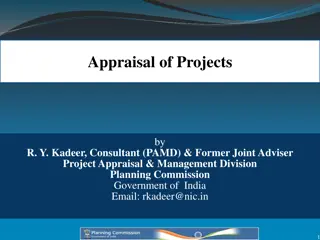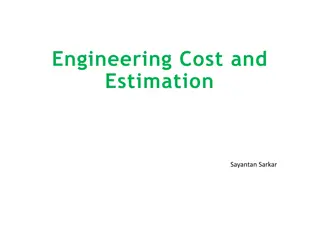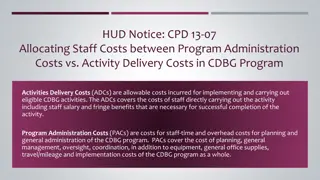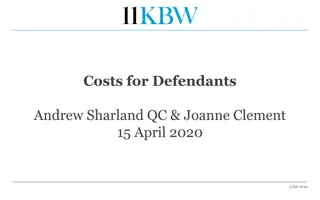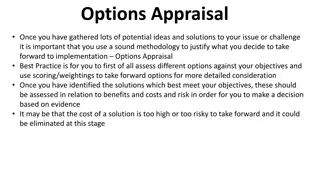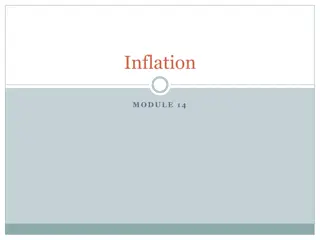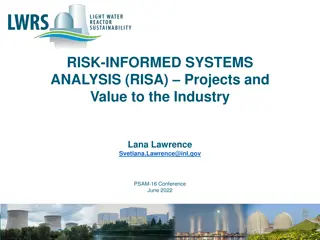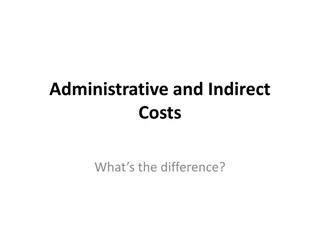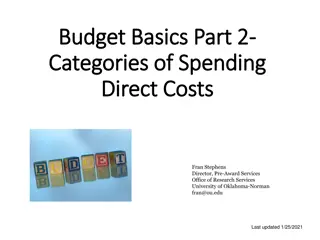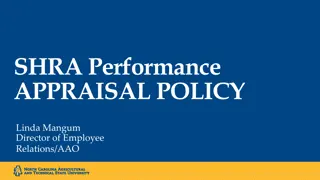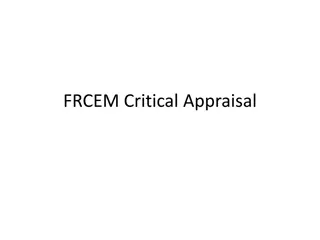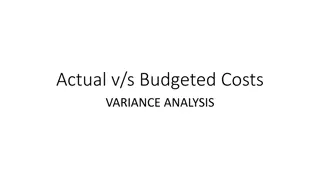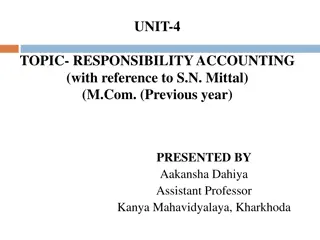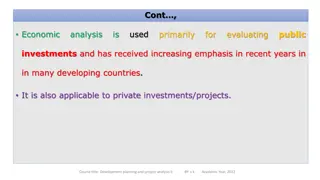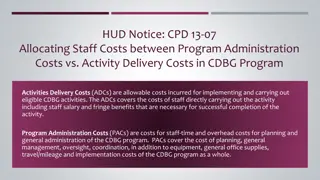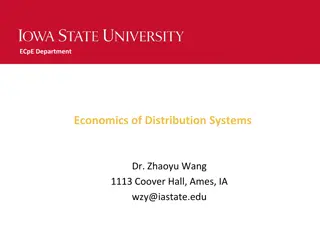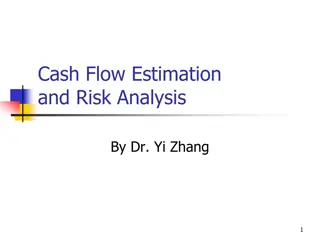Financial Analysis and Appraisal of Projects: Understanding Costs and Benefits
Financial analysis in project management involves evaluating the feasibility and viability of a project through assessing its costs and benefits. This analysis helps in determining the financial soundness of a project and guides decision-making regarding investment profitability and sensitivity to market conditions.
- Financial Analysis
- Project Management
- Feasibility Assessment
- Investment Profitability
- Market Conditions
Download Presentation

Please find below an Image/Link to download the presentation.
The content on the website is provided AS IS for your information and personal use only. It may not be sold, licensed, or shared on other websites without obtaining consent from the author. Download presentation by click this link. If you encounter any issues during the download, it is possible that the publisher has removed the file from their server.
E N D
Presentation Transcript
Chapter - 2: Financial Analysis and Appraisal of Projects oThe main content of the chapter are: Scope and Rationale Identification of Costs and Benefits Classification of Costs and Benefits The valuation of financial costs and benefits Investment Profitability Analysis Sensitivity analysis Course title: Devleopment planning and project analysis II BY: s k. Acadekic Year, 2018
Scope and Rationale What is financial analysis? Every project has to be first analyzed in terms of its timely implementation and financing. It aims at confirming that under prevailing market conditions the project will become and remain viable. It is concerned with assessing the feasibility of a new project from the point of view of its financial results. Course title: Development planning and project analysis II BY: s k. Academic Year, 2012 2
Cont, The project s direct benefits and costs are, therefore, calculated in monetary terms at the prevailing market prices. This analysis is applied to appraise the soundness and acceptability of a single project. A comprehensive financial analysis provides the basic data needed for the economic evaluation of the project and is the starting point for such evaluation. Course title: Development planning and project analysis II BY: s k. Academic Year, 2012 3
Cont, It has to be noted that the financial analyst should be able to communicate and know what to ask from the d/t team members to collect relevant information on: 1. Revenue, both forecasted sales and selling price; (from Demand and Market Study) Course title: Development planning and project analysis II BY: s k. Academic Year, 2012 4
Cont, 2. Initial investment costs distributed over the implementation of the project; (Engineering, Site Development as well as Materials and Inputs); 3. Operating costs / over its operating life. Course title: Development planning and project analysis II BY: s k. Academic Year, 2012 5
Identification of Costs & Benefits In project analysis, the identification of costs and benefits is the first step. This involves: The specification of the costs and benefit of variables for which data should be collected, Identification of the sources of information, and Assessment of the quality and reliability of the collected information. Course title: Development planning and project analysis II BY: s k. Academic Year, 2012 6
Cont, The costs and benefits of a project depend on the objectives the project wants to achieve. A cost is anything that reduces an objective, and a benefit is anything that contributes to an objective. The objective of the project may be: To maximize family net income /profit. Increase national income Course title: Development planning and project analysis II BY: s k. Academic Year, 2012 7
Cont, Income distribution. Increase job opportunities Raising the level of education, Improve rural health, & etc. The dominant objective of the firm s project is maximization of income/profit and increased national income is the most important objective of national economic policy. Course title: Development planning and project analysis II BY: s k. Academic Year, 2012 8
Cont, Thus, anything that directly reduces the total finalgoods and services is obviously a cost, and anything that directly increases them is a benefit. Again, anything that reduces national income is a cost and anything that increases national income is a benefit. Course title: Development planning and project analysis II BY: s k Academic Year, 2012 9
Classifications of Cost and Benefits There are alternative ways of classifying costs and benefits of a project. One is to categorize both costs and benefits into: Tangible and intangible: The prices that the project actually pays for inputs are the appropriate prices to use to estimate the project s financial costs. These prices may include taxes, tariffs, rents, or be net of subsidies. Course title: Development planning and project analysis II BY: s k. Academic Year, 2012 10
Cont, Some of the project costs are tangible and quantifiable while many more are intangible and non quantifiable. The costs of a project depend on the exact project formulation, location, resource availability, or objective of the project. Tangible benefits can arise either from increased production or from reduced costs. Course title: Development planning and project analysis II BY: s k. Academic Year, 2012 11
Cont, In general the following benefits can be expected: Increased production Quality improvement Changes in time of sale changes in location of sale Changes in product form (grading) Cost reduction through technological advancement & etc. Course title: Development planning and project analysis II BY: s k. Academic Year, 2012 12
Another classification: 1. Total investment costs; including: a. Initial investment costs; Fixed investment costs; The cost of land and site development The cost of buildings and civil works Plant and machinery Miscellaneous fixed assets (furniture) Course title: Development planning and project analysis II BY: s k. Academic Year, 2012 13
Cont, Pre-Production expenditures; This includes the following investment cost items. Intangible assets; These include: oPatents, licenses, engineering fees, and goodwill. oPreparatory studies, like feasibility studies, consultant fees for preparing studies, supervision costs, & etc. Course title: Development planning and project analysis II BY: s k Academic Year, 2012 14
Cont, Other Pre-operation expenses. These include: oRents, taxes, Salaries, and others oPre-production marketing costs, promotional expenses, creation of sales network, etc.; oTraining costs, including all fees, travel, living expenses etc.; oInsurance charges; Course title: Development planning and project analysis II BY: s k. Academic Year, 2012 15
Cont, oInterest on loan, oMiscellaneous expenses Course title: Development planning and project analysis II BY: s k. Academic Year, 2012 16
b. Plant and Equipment Replacement Costs Every machinery and equipment does not have equal economic life. Even though there are machineries and equipment that productively be operated for many years, there are also equipment, machinery components and parts which need to be regularly replaced for smooth operation of the same technology. Course title: Development planning and project analysis II BY: s k. Academic Year, 2012 17
Cont, So sound project planning work should adequately provide for replacement of components and parts. In fact the first thing to do would be to identify such items and then estimate the costs for replacement . Course title: Development planning and project analysis II BY: s k. Academic Year, 2012 18
2. Operating costs This may includes Material cost Utilities: consisting of power, water, and fuel are also important cost components. Labor: this is the cost of all manpower employed in the enterprise. Factory Overhead: the expense on repairs and maintenance, rent, taxes, insurance on factory assets, etc. Course title: Development planning and project analysis II BY: s k. Academic Year, 2012 19
Cont, Contingency allowances are usually included as a regular part of the project cost. It would be unrealistic to base project cost estimates only on these assumptions of perfect knowledge and complete price stability. Course title: Development planning and project analysis II BY: s k. Academic Year, 2012 20
Cont, Sound project planning requires that provision be made in advance for possible adverse changes in physical conditions or prices that would add to the baseline cost. Contingency allowances may be divided into those that provide for physical contingencies and those for price contingencies. In turn price contingencies comprises two categories, those for relative changes in price and those for general inflation. Course title: Development planning and project analysis II BY: s k. Academic Year, 2012 21
Cont, To avoid the problem of inflation on the other hand it is advisable to work with constant prices instead of current prices. Course title: Development planning and project analysis II BY: s k. Academic Year, 2012 22
The Valuation of Financial Cost and Benefits This is an issue of pricing/valuing/ of the project s inputs and outputs. The inputs and outputs of a project appear in physical form and prices are used to express them in value terms. The financial benefits of a project are just the revenues received and the financial costs are the expenditures that are actually incurred by the implementing agency as a result of the project. Course title: Development planning and project analysis II BY: s k. Academic Year, 2012 23
Cont, If the project is producing some goods and services for sale, the revenue that the project implementer expects to receive every year from these sales will be the benefits of the project. The costs incurred are the expenditures made to establish and operate the project. In financial analysis all receipts and expenditures are valued as they appear in the financial balance sheet of the project, and are therefore, measured in market prices. Course title: Development planning and project analysis II BY: s k. Academic Year, 2012 24
Cont, Since the project implementers will have to pay market prices for the inputs and will receive market prices for the outputs they produce, the financial costs and benefits of the project are measured in these market prices. Course title: Development planning and project analysis II BY: s k. Academic Year, 2012 25
Investment Profitability Analysis A. Non-discounting (traditional) measures of project worth 1. Payback Period (PBP) 2. Accounting Rate of Return (ARR) 1. Payback Period (PBP) Payback period refers to the length of time it takes to recover initial investment of the project. Depending on the nature of net cash flows, payback period may be computed in two ways. Course title: Development planning and project analysis II BY:s k. Academic Year, 2012 26
Cont, a) When cash flow is in annuity form (even cash flows) Annuity refers to equal amount of cash flows that occur every period over the life of the project. Initial Investment PBP = Annual Net Cash Flows Course title: Development planning and project analysis II BY: s k Academic Year, 2012 27
Cont, To illustrate the computation of payback period, assume that a project requires an initial investment of Br. 24,000 and annual after tax cash flows of Br. 6000 for five years. How long it takes the company to recover its initial investment? 24 , 000 PBP = = 4 years 6000 Course title: Development planning and project analysis II BY: s k. Academic Year, 2012 28
Cont, It is expected to take the company four years to recover the project s initial investment of Br. 24,000 b) When cash flows are not in annuity form (Uneven cash flows) When net cash flows are not annuity, payback period is obtained by adding net cash flows for successful years until the total is equal to initial investment. Course title: Development planning and project analysis II BY: s k. Academic Y ear, 2012
Cont, PBP= Years before full recovery + Un recovered cost Cash flow during the next year To exemplify, assume that a project requires an initial investment of Br. 60,000. The after taxes cash flows (or net cash flows) are as follows: Year 1 = 8000 Year 3 = 22,000 Year 5 = 20,000 Year 2 = 15,000 Year 4 = 20,000 Course title: Development planning and project analysis II BY: s k. Academic Year, 2012 30
Cont, The payback period is computed as follows; 15 000 , PBP = 3 years + = 3.75 years 20 000 , In the above example, if the 1st three years net cash flows are added, the sum is equal to Br. 45,000. But the initial investment is Br. 60,000. Course title: Development planning and project analysis II BY: s k. Academic Year, 2012 31
Cont, If the fourth year net cash flows (Br. 20,000) is added to Br. 45,000, the sum is Br. 65,000 which is greater than the initial investment. Thus, the payback period is between year 3 and year 4. To find the exact payback period, we take the three years and divide the remaining cash flows by the fourth year net cash flows. Course title: Development planning and project analysis II BY: s k. Academic Year, 2012 32
Cont, If the exact payback period is needed in months the fraction can be computed as follows: 15 000 , 12 ( ) months PBP = 3 years + 20 000 , = 3 years and 9 months The shorter the payback period, the more desirable the project. Course title: Development planning and project analysis II BY: s k. Academic Year, 2012 33
Cont, Advantages of Payback Period It is simple both in concept and application It is a rough and ready made method for dealing with risk & etc. Disadvantages of Payback Period It fails to consider time value of money It ignores cash flows beyond the payback period It is a measure of the project s capital recovery, not profitability & etc. Course title: Development planning and project analysis II BY:s k Acdemic Year, 2012
2. Accounting/Average Rate of Return (ARR) The accounting rate of return is a measure of profitability which relates/compare net income to investment. Compare The most common method of computing ARR, is shown below; Course title: Development planning and project analysis II BY: s k. Academic Year, 2012 35
Cont, To illustrate, assume that a project has original investment of Br. 70,000, life of 4 years, and salvage value of Br. 6000. Income before depreciation and taxes for each of the four years are as follows: year1, Br. 40,000; year 2, Br. 42,000; year 3, Br. 36,000; and year 4, Br. 50,000. Income tax rate is 40%. Course title: Development planning and project analysis II BY: s k. Academic Year, 2012 36
Cont, Depreciation = 70,000 6000 = 16,000 4 Before ARR is determined, it is necessary to compute net income for each of the four years as follows: Course title: Development planning and project analysis II BY: s k. Academic Year, 2012 37
Cont, Year 1 Year 2 Year 3 Year 4 Income before depreciation & tax 40,000 42,000 36,000 50,000 Less: Depreciation 16,000 16,000 16,000 16,000 Income before taxes 24,000 26,000 20,000 34,000 Less: Taxes (40%) 9,600 10,400 8,000 13,600 Net income 14,400 15,600 12,000 20,400 Course title: Development planning and project analysis II BY: s k Academic Year, 2012 38
Cont, Course title: Development planning and project analysis II BY: s k. Academic Year, 2012 39
Cont, The ARR for a project proposal shall be compared with a required rate of return (normal saving interest rate). Therefore, if we compare the ARR of the project proposals in our example, say with an interest rate of 36%, the proposal is good for implementation. Decision Rule for Accounting Rate of Return Accept the project if ARR exceeds the required rate of return. Reject the project if ARR is less than the required rate of return. Course title: Development planning and project analysis II BY: s k Academic Year, 2012
Advantages of ARR 1. It is simple to calculate 2. It is based on accounting information, which is readily available and familiar to businessmen. 3. It considers benefits over the entire life of the project & etc. Limitations of ARR 1. It is based upon accounting profit. 2. It does not take into account the time value of money & etc. Course title: Development planning and project analysis II BY: s k Academic Year, 2012
Discounted Cash Flows (DCF) measures of project worth 1. Net Present Value Method The net present value of project is the d/ce b/n the present value of net cash inflows and present value of initial investment. Or; NPV = PV of NCF I0 Where: PV = Present value and NCF = Net cash flows Course title: Development planning and project analysis II BY: s k. Academic Year, 2012 42
Cont, To illustrate, assume that a project is expected to have initial investment and life of Br. 40,000 and five years respectively. The annual after tax net cash flow is estimated at Br. 12,000 for each of the five years & the required rate of return is 10%. Course title: Development planning and project analysis II BY: s k Academic Year, 2012
Cont, Net present value is determined as follows: NPV = PV of NCF I0 = 12,000 (3.791) 40,000 = 45,492 40,000 = 5492 Course title: Development planning and project analysis II BY: s k. Academic Year, 2012 44
Cont, In the above formula, represents the discount factor and its value is equal to 3.791. This discount factor can be taken from the present value of annuity table from the intersection of i = 10% and n = 5. It can also be determined using your calculator. Course title: Development planning and project analysis II BY: s k Academic Year, 2012 45
Cont, In the above example, net cash flows are annuity. The same procedure can be followed if net cash flows are not in annuity form. To illustrate the computation of NPV when net cash flows are not annuity, suppose the project has initial investment and useful life of Br. 30,000 and four years respectively. Its annual cash flows are as follows: Year 1, Br. 10000; Year 2, Br. 8000; year 3, Br. 15000; and year 4, Br. 12,000. Course title: Development planning and project analysis II BY: s k Academic Year, 2012 46
Cont, If the required rate of return is 10%, NPV is determined as follows: Course title: Development planning and project analysis II BY: s k. Academic Year, 2012 47
Cont, NPV represents the amount by which the value of (wealth of) the firm will increase if the project is accepted. Decision Rule for NPV If NPV is greater than zero (NPV > 0), the project is considered desirable. If NPV is less than 0, the project is considered undesirable. Course title: Development planning and project analysis II BY: s k. Academic Year, 2012 48
2. Internal Rate of Return (IRR) Internal Rate of Return is the discount rate which equates the project NPV equal to zero. It is the discount rate at which the present value of Net cash flows is equal to the present value of initial investment. In other words, IRR is the rate of return on investments in the project. The determination of IRR is purely based on project cash flows. Course title: Development planning and project analysis II BY: s k Academic Year, 2012 49
Cont, IRR is determined using trial and error: the complexity of determining IRR is greater if net cash flows are not in annuity form. This section illustrates the determination of net cash flows when cash flows are annuity as well as non-annuity. Course title: Development planning and project analysis II BY: s k Academic Year, 2012 50



